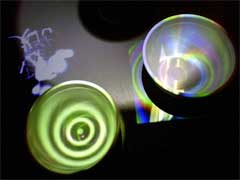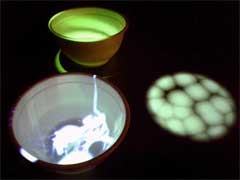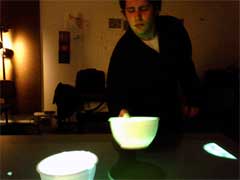
WORMHOLE
WORMHOLE [working title] is a networked installation, connecting at least two remote sites. At each site, images are projected from above onto a square tabletop. The positions of several white saucers on each table are optically tracked. Each saucer has an infrared LED at its center, which is tracked by a black and white CCTV camera equipped with an IR pass filter. Participants can use the saucers to scoop up projected objects from the table surface, move them, interact with them, and change them in various ways. At the center of each table surface is a funnel-shaped depression, representing a wormhole that connects the tables together across networked space. A virtual gravitational force, progressively stronger towards the center of the table, gradually pulls all projected images into this hole. When something is pulled into one of these wormholes, it disappears and re-emerges out of the wormhole at another networked location. Thus, a participant at one site can manipulate and mutate an object and then send it as an obscure 'message' to participants at the other site. Each table can be imagined to be upside-down in relation to the other, with the wormhole as a virtual passage from one to the other.

A panoramic view of the participants is captured by a video camera (or stitched together from several video cameras), and this live image is used as a reflection map for the projected objects and environment. Participants thus see themselves reflected in the objects they construct.
Initially, participants are faced with a reflective table surface plane. The environment is fluid, metallic. Everything is being pulled slowly but inexorably into the wormhole. Small spheres and crystals rise to the surface. Small objects are constantly bubbling up and melting down into the table.

Participants use the saucers to isolate and select features of the environment. By picking up objects and manipulating and combining them in various ways, users at each table collaborate to create abstract three-dimensional structures. The surfaces of these structures reflect the users' own environment, situating the structures in their local context.
When users are done making a structure, they can allow it to be sucked into the wormhole, where it disappears from their point of view. It pops up out of the wormhole at a remote table, still reflecting the environment where it was created. In this way, objects bring their environment with them. Microphones at each site capture audio as well, so that participants can converse across sites, as long as a structure from the opposite site is present. The ambient light color at each table is distinct, so that objects are to some extent color-coded with the table of their origin.

After an object pops up, it can be further manipulated in its new setting. As users change and augment the object, it slowly starts to reflect its current environment, losing the reflections it had when it arrived. If the object is ignored, it melts down into the table surface. So it only retains its status as an emissary of the previous table setting for a limited amount of time.